Snake plants, also known as Sansevieria, are a popular houseplant known for their air-purifying properties and low maintenance. However, if you start noticing yellow leaves on your snake plant, it could be a sign that something is wrong. As a plant parent, it’s important to understand the possible causes of Snake Plant Leaves Turning Yellow and how to fix them to keep your snake plant healthy and thriving.
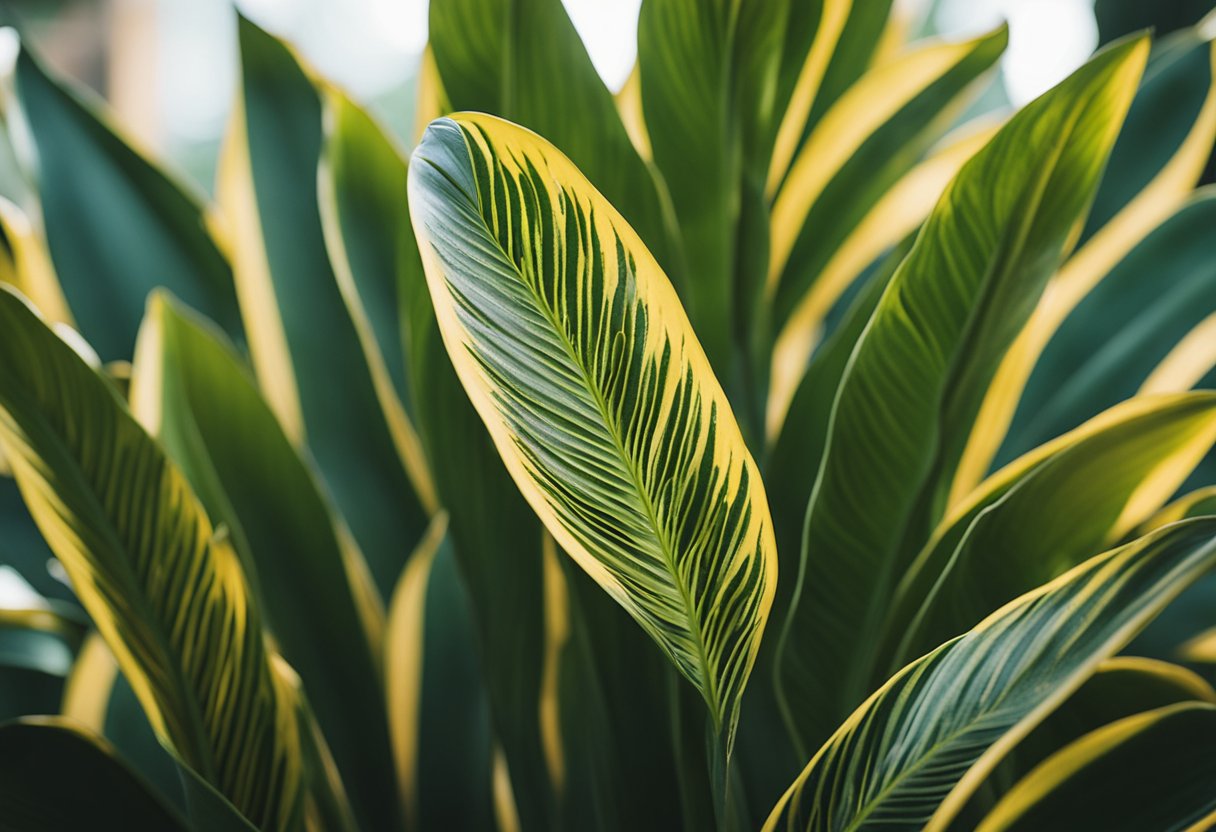
There are several reasons why snake plant leaves may turn yellow, including overwatering, underwatering, poor light conditions, pests, and disease. Understanding the underlying cause of yellowing leaves is key to correcting the problem and preventing further damage to your plant. In this article, I will discuss the common causes of snake plant yellowing and provide tips on how to fix and prevent this issue in the future.
Key Takeaways
- Snake plant leaves may turn yellow due to overwatering, underwatering, poor light conditions, pests, and disease.
- Correcting the underlying cause of yellowing leaves is key to restoring the health of your snake plant.
- Preventive care and maintenance, such as proper watering practices and environmental stress management, can help keep your snake plant healthy and prevent yellowing leaves.
Understanding Snake Plant Yellowing
Snake plants are popular houseplants due to their low maintenance and air-purifying qualities. However, yellowing leaves can be a common problem for snake plant owners. In this section, I will discuss the causes of yellow leaves and the natural aging process of snake plants.
Causes of Yellow Leaves
There are several reasons why snake plant leaves may turn yellow. One of the most common causes is overwatering. Snake plants are drought-tolerant and do not require frequent watering. Overwatering can lead to root rot, which can cause the leaves to turn yellow and eventually die.
Another cause of yellowing leaves is exposure to cold temperatures. Snake plants prefer warm temperatures and should be kept away from cold drafts. If a snake plant is exposed to cold temperatures, the leaves may turn yellow and become damaged.
Excess fertilizer can also cause snake plant leaves to turn yellow. While snake plants do require some fertilizer, too much can be harmful. It is important to follow the instructions on the fertilizer package and not to over-fertilize.
Natural Aging Process
It is important to note that snake plants naturally shed their leaves as they age. As the plant grows, old leaves will turn yellow and die, making way for new growth. This is a natural process and should not be a cause for concern. However, if the yellowing leaves are accompanied by other symptoms such as wilting or brown spots, it may be a sign of a more serious issue.
Yellowing leaves on snake plants can be caused by overwatering, exposure to cold temperatures, excess fertilizer, or the natural aging process. By understanding these causes, snake plant owners can take steps to keep their plants healthy and thriving.
Watering Practices
As a snake plant owner, it is essential to understand the proper watering practices to prevent yellowing leaves. In this section, I will discuss the symptoms of overwatering and underwatering, as well as proper watering techniques.
Overwatering Symptoms
Overwatering is one of the most common causes of yellowing leaves in snake plants. If you notice that the leaves are turning yellow and feel soft or mushy to the touch, it indicates that the roots might be waterlogged, leading to root rot. Other symptoms of overwatering include:
- Wilting leaves
- Brown or black spots on the leaves
- Foul odor
If you suspect that your snake plant is overwatered, it is crucial to adjust your watering practices immediately to prevent further damage.
Underwatering Symptoms
Underwatering is another potential cause of yellowing leaves in snake plants. If the yellow leaves are dry and crispy to the touch, it suggests that the plant is not receiving sufficient water. Other symptoms of underwatering include:
- Wrinkled or shriveled leaves
- Slow or stunted growth
- Brown tips on the leaves
If you suspect that your snake plant is underwatered, it is essential to adjust your watering practices immediately to prevent further damage.
Proper Watering Techniques
The key to preventing yellowing leaves in snake plants is to establish proper watering techniques. Here are some tips to keep in mind:
- Water your snake plant thoroughly but infrequently. Allow the soil to dry out completely between waterings.
- Use well-draining soil to prevent water from accumulating in the pot.
- Avoid getting water on the leaves, as this can lead to fungal diseases.
- Consider using a moisture meter to monitor the soil’s moisture level.
By following these proper watering techniques, you can help prevent yellowing leaves in your snake plant and keep it healthy and thriving.
Light Requirements
As a snake plant owner, it’s important to understand the light requirements of your plant. Proper lighting is crucial for the growth and overall health of your snake plant. In this section, I will discuss the two main light-related causes of yellowing snake plant leaves: too much light and insufficient light.
Too Much Light
One common cause of yellowing snake plant leaves is too much direct sunlight. Snake plants prefer bright, indirect light, so placing them in direct sunlight for extended periods can cause the leaves to turn yellow and even burn. If you notice that your snake plant is getting too much light, move it to a spot with more shade or indirect light.
Insufficient Light
On the other hand, insufficient light can also cause snake plant leaves to turn yellow. If your snake plant is not getting enough light, it may start to lose its vibrant green color and the leaves may turn yellow and droop. To prevent this, make sure your snake plant is placed in a spot with bright, indirect light. If your snake plant is not getting enough light, consider moving it closer to a window or investing in a grow light.
It’s important to strike a balance between too much and too little light for your snake plant. Keep an eye on your plant and adjust its placement as needed to ensure it’s getting the right amount of light.
Also Read | 10 Small Flowers for the Nooks and Crannies in Your Garden
Soil and Fertilization
As a plant owner, one of the most important things to consider when caring for your snake plant is the soil quality and fertilization. These two factors can greatly affect the health of your plant, and can often be the cause of yellowing leaves.
Soil Quality and Composition
Snake plants prefer well-draining soil that is slightly acidic, with a pH level between 5.5 and 7.5. If the soil is too dense or retains too much moisture, it can lead to root rot and other issues that can cause the leaves to turn yellow.
To ensure proper soil quality, use a well-draining potting mix that is specifically formulated for snake plants. You can also add perlite or sand to the soil to improve drainage. Additionally, it is important to repot your snake plant every few years to ensure that the soil remains fresh and free of buildup.
Fertilizer Use and Overfertilization
While snake plants generally do not require a lot of fertilizer, it is important to provide them with the necessary nutrients to promote healthy growth. However, overfertilization can be just as harmful as underfertilization, and can cause yellowing leaves and other issues.
When fertilizing your snake plant, it is important to use a balanced fertilizer with equal amounts of nitrogen, phosphorus, and potassium. It is also important to follow the instructions on the fertilizer packaging and not to exceed the recommended amount.
Maintaining proper soil quality and fertilization is crucial for the health and vitality of your snake plant. By using a well-draining soil mix and fertilizing in moderation, you can ensure that your plant remains healthy and vibrant for years to come.
Pest and Disease Management
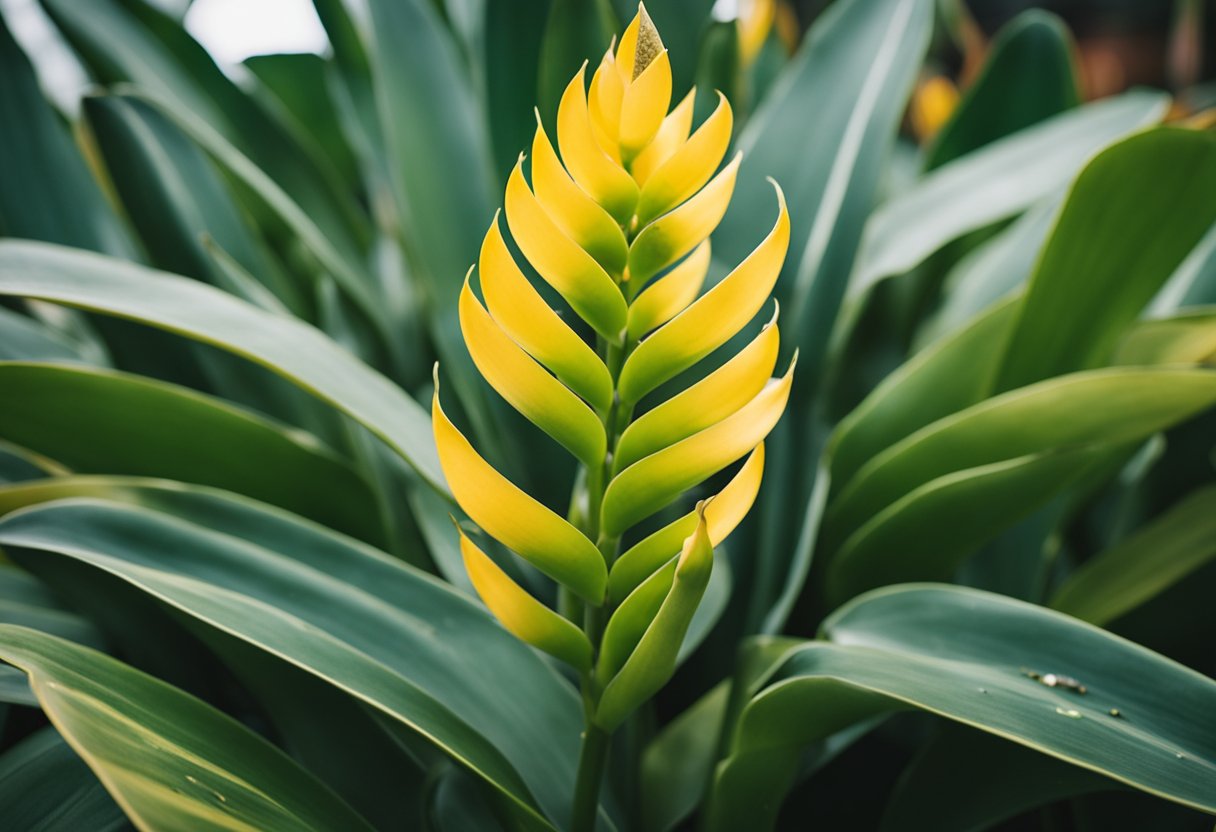
As with any plant, snake plants are susceptible to pests and diseases. However, with proper care and attention, you can prevent and manage these issues.
Common Pests
There are a few common pests that may affect your snake plant, including spider mites, mealybugs, and scale insects. These pests can cause yellowing of the leaves, as well as other damage.
To prevent and manage pest infestations, I recommend regularly inspecting your snake plant for signs of pests. If you notice any, isolate the plant and treat it with an appropriate insecticide or pesticide. Be sure to follow the instructions carefully and avoid overuse, as this can harm the plant.
Disease Prevention
Preventing diseases in your snake plant is largely a matter of proper care. Be sure to avoid overwatering, as this can lead to root rot and other issues. Additionally, make sure your snake plant has good drainage and is planted in well-draining soil.
If you do notice signs of disease, such as yellowing leaves, act quickly to prevent the spread of the disease. Remove any affected leaves and isolate the plant if necessary. Additionally, consider adjusting your care routine to prevent further issues. For example, you may need to adjust your watering schedule or provide more or less light depending on the specific issue.
By taking these steps, you can prevent and manage pest and disease issues in your snake plant, keeping it healthy and vibrant for years to come.
Environmental Stress Factors
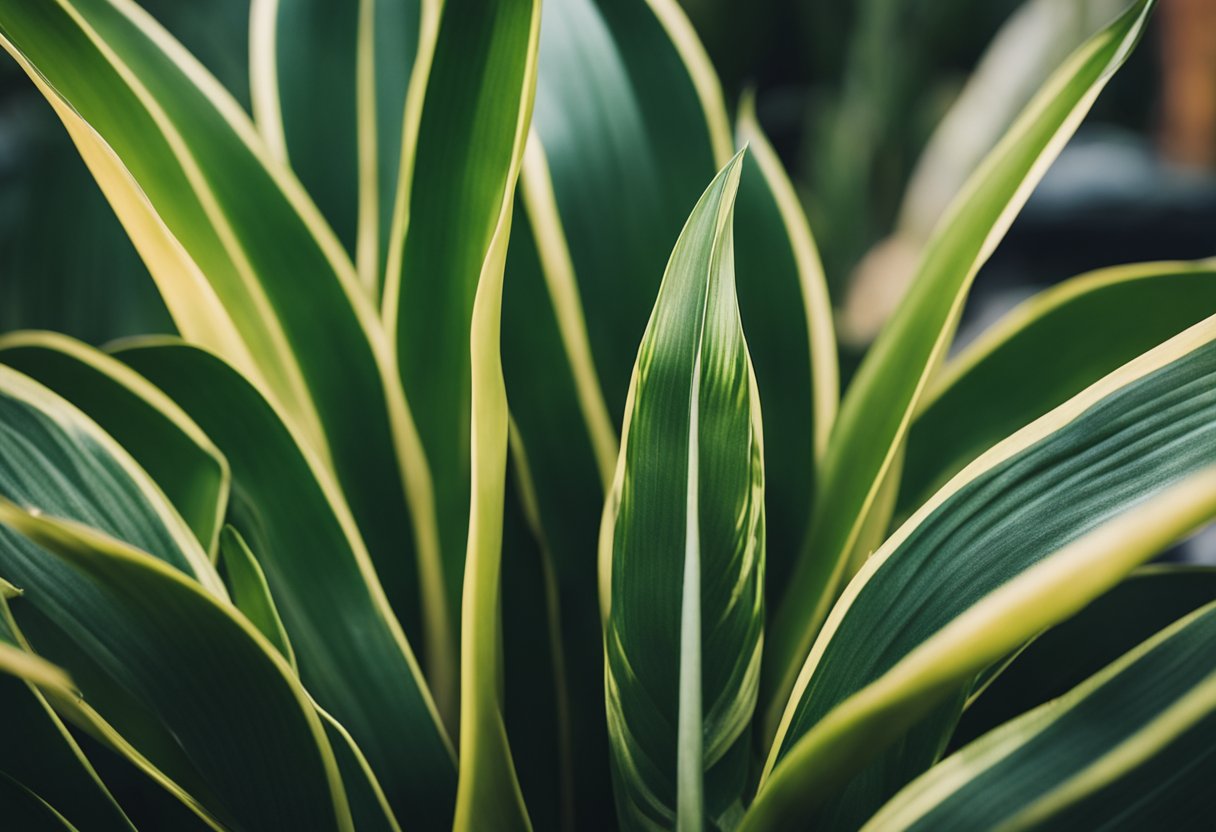
As a plant enthusiast, I know that environmental stress factors can cause snake plant leaves to turn yellow. These factors include temperature extremes and humidity levels.
Temperature Extremes
Snake plants like it warm, between 60-90°F to be precise. If temperatures dip below this range, your snake plant will experience stress. As a result, its leaves may turn yellow. On the other hand, too much heat can also cause stress and yellowing of leaves.
It’s essential to place your snake plant in a warm area, free from both hot and cold drafts. It will happily tolerate most radiators and other heat sources. It’s also crucial to maintain a consistent temperature to avoid stressing the plant.
Humidity Levels
Snake plants thrive in environments with moderate humidity levels. Low humidity levels can cause stress and yellowing of leaves. On the other hand, high humidity levels can lead to fungal infections and root rot.
To maintain moderate humidity levels, you can place a tray of water near the plant or use a humidifier. It’s also essential to avoid overwatering the plant, which can lead to waterlogged soil and root rot.
By understanding and managing these environmental stress factors, you can help your snake plant maintain its vibrant and healthy foliage.
Repotting and Root Care
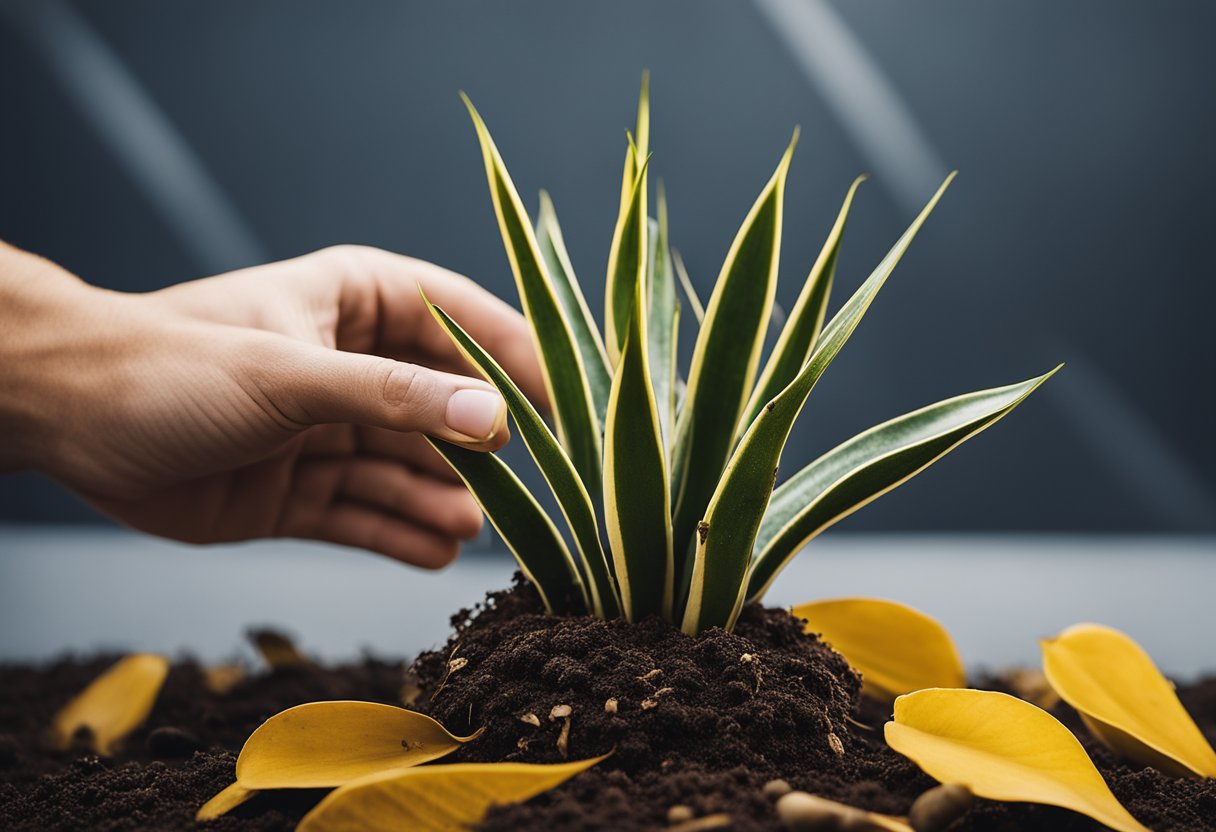
Repotting is an essential aspect of caring for snake plants, especially when the leaves start turning yellow. When you notice yellowing leaves, it could be a sign that the plant has outgrown its current pot, or the soil is depleted of nutrients. Repotting can help address these issues and give the plant a fresh start.
When to Repot
Snake plants should be repotted every two to three years, or when the plant has outgrown its current pot. Signs that your snake plant needs repotting include roots growing out of the drainage holes, a pot that feels too heavy, or the plant becoming root-bound.
The best time to repot a snake plant is in the spring or summer when the plant is actively growing. Repotting during the dormant season can shock the plant and cause it to take longer to recover.
Root Inspection
Before repotting your snake plant, it’s essential to inspect the roots for any signs of damage or disease. Healthy snake plant roots are firm, white, and plump. If the roots are brown, mushy, or have a foul odor, it’s a sign of root rot.
To inspect the roots, gently remove the plant from its pot and shake off any excess soil. Use a pair of clean, sharp scissors to trim any damaged or diseased roots. Be sure to sterilize the scissors before using them to prevent the spread of disease.
Repotting and root care are crucial aspects of caring for a snake plant. Repotting every two to three years and inspecting the roots for damage or disease can help keep your plant healthy and prevent yellowing leaves.
Preventive Care and Maintenance
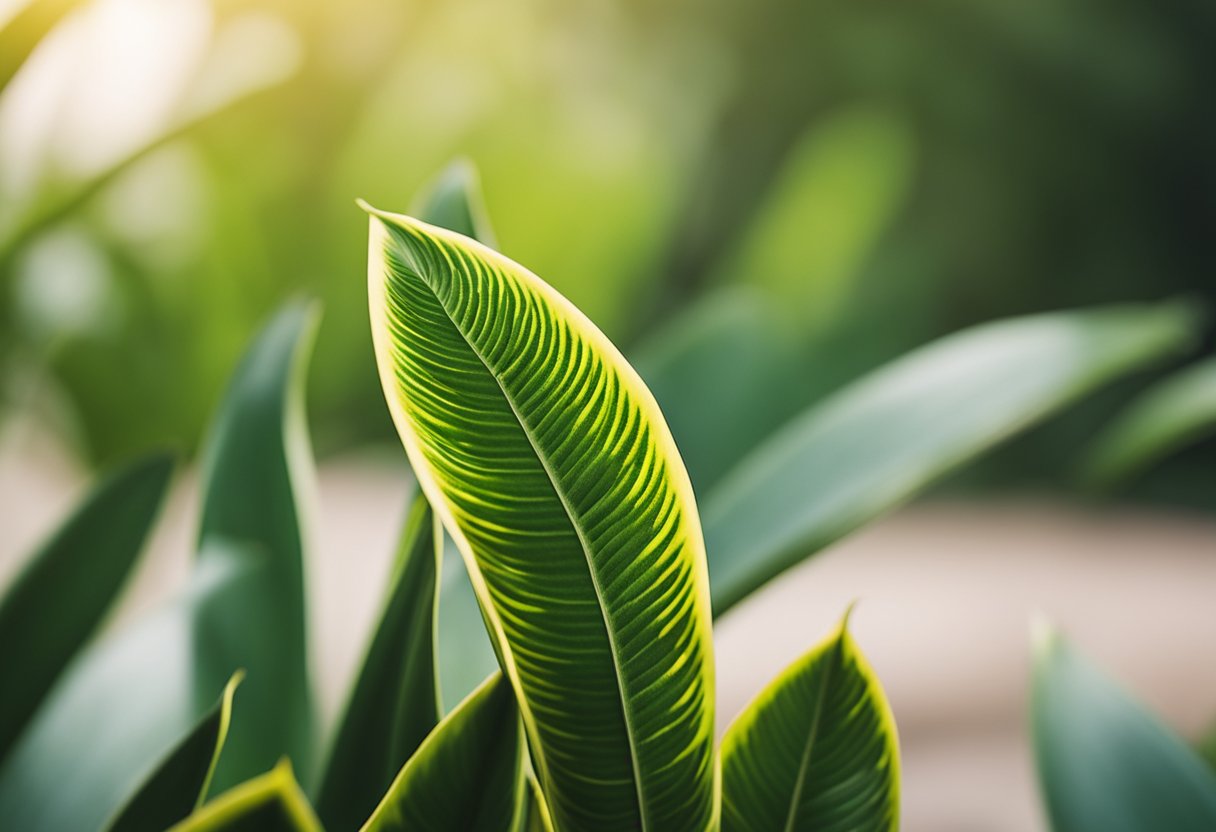
As with most plants, preventive care and maintenance are key to keeping your snake plant healthy and vibrant. Here are some tips to help prevent your snake plant leaves from turning yellow:
Proper watering
Overwatering is one of the most common causes of yellowing snake plant leaves. I recommend watering your snake plant every two to three weeks, depending on the humidity and temperature of your environment. You should also ensure that the soil is well-draining and that you’re not letting your snake plant sit in standing water.
Adequate lighting
Snake plants prefer bright, indirect light, but they can also tolerate low-light conditions. However, if your snake plant is not getting enough light, it may start to turn yellow. I recommend placing your snake plant near a window that gets indirect sunlight or using a grow light if you don’t have access to natural light.
Proper soil
Snake plants prefer well-draining soil. If the soil is too dense or compact, it can prevent water from properly draining, leading to root rot and yellowing leaves. I recommend using a light, loamy mix of potting soil, perlite, and peat moss or coconut coir to ensure proper drainage.
Fertilization
Snake plants generally do not require much fertilizer, but if it’s been a few years since you fed your plant or gave it fresh soil, a nutrient deficiency could cause leaves to yellow. However, overfeeding can also cause dry, pale leaf edges and wilting. I recommend fertilizing your snake plant once a year with a balanced houseplant fertilizer.
By following these tips, you can help prevent your snake plant leaves from turning yellow and keep your plant healthy and thriving.
FAQs – Snake Plant Leaves Turning Yellow
How can I distinguish between overwatering and underwatering in my snake plant?
Overwatering and underwatering can both cause yellowing of snake plant leaves. To distinguish between the two, you should check the soil moisture level. If the soil is soggy and the pot doesn’t have proper drainage, your snake plant may be overwatered. If the soil is dry and the leaves are wilted, it may be underwatered. You can also check the roots of the plant to see if they are mushy and brown (overwatered) or dry and brittle (underwatered).
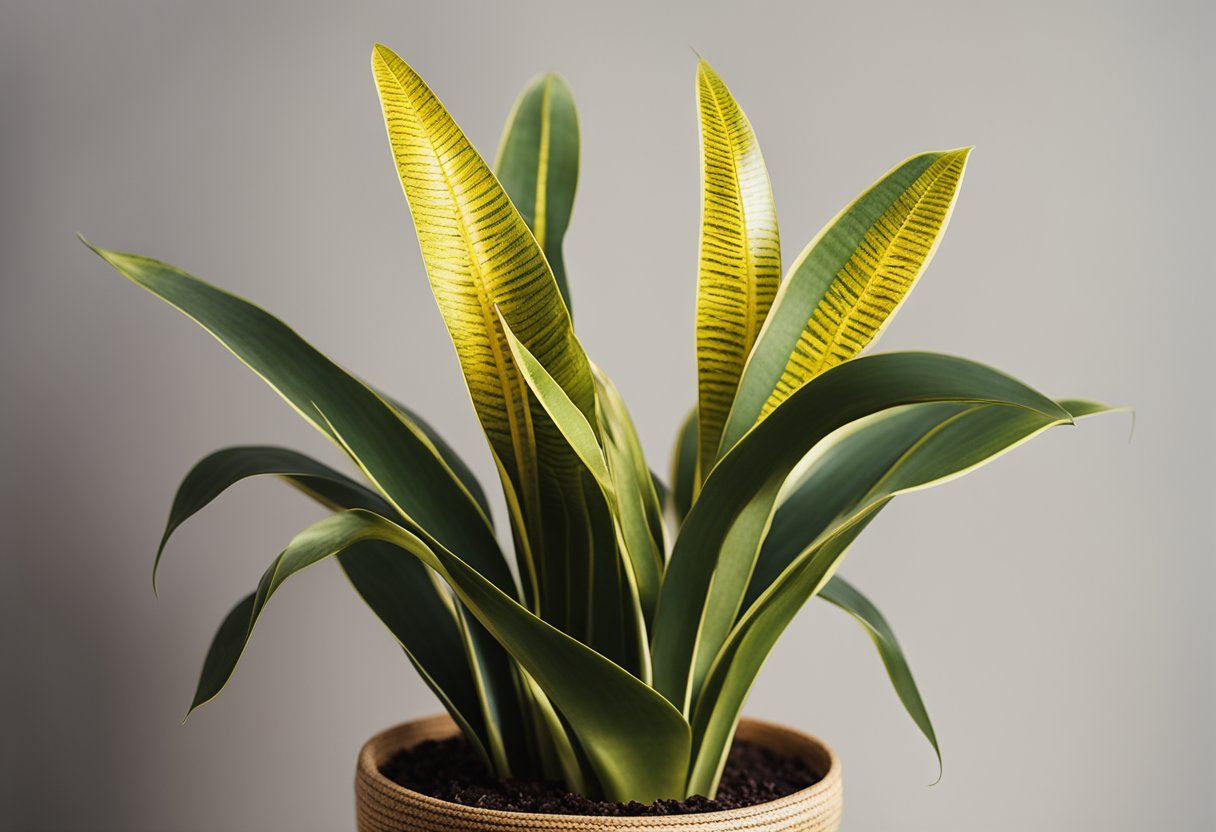
What steps should I take to restore the green color of yellowing snake plant leaves?
To restore the green color of yellowing snake plant leaves, you should first identify the cause of the yellowing. If the cause is overwatering, you should stop watering the plant for a while and allow the soil to dry out. If the cause is underwatering, you should water the plant more frequently. You can also trim off the yellow leaves to encourage new growth. Additionally, you can fertilize your snake plant with a balanced fertilizer to promote healthy growth.
Why are my snake plant leaves developing brown spots or edges?
Brown spots or edges on snake plant leaves can be caused by a variety of factors, including overwatering, underwatering, low humidity, pests, or disease. To prevent brown spots or edges, you should ensure that your snake plant is not over or underwatered, and that it is not exposed to extreme temperatures or direct sunlight. You can also increase the humidity around your plant by misting it or placing a tray of water nearby.
How often should a snake plant be watered for optimal health?
Snake plants prefer to be slightly underwatered, so you should only water them when the soil is dry to the touch. Depending on the temperature and humidity of your home, this may be every 2-4 weeks. It’s important not to overwater your snake plant, as this can lead to root rot and other issues.
What are the signs of an overwatered snake plant?
Signs of an overwatered snake plant include yellowing leaves, mushy roots, and a foul odor coming from the soil. If you suspect that your snake plant is overwatered, you should stop watering it for a while and allow the soil to dry out. You can also repot the plant in fresh, well-draining soil to prevent future overwatering.
Why are my snake plant leaves starting to curl, and how can I remedy this?
Curling snake plant leaves can be caused by a lack of water, low humidity, or pests. To remedy this, you should ensure that your snake plant is watered regularly and that the humidity around it is increased. You can also inspect the plant for pests and treat it with an appropriate insecticide if necessary.